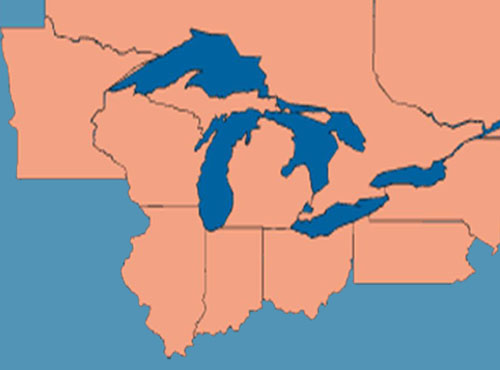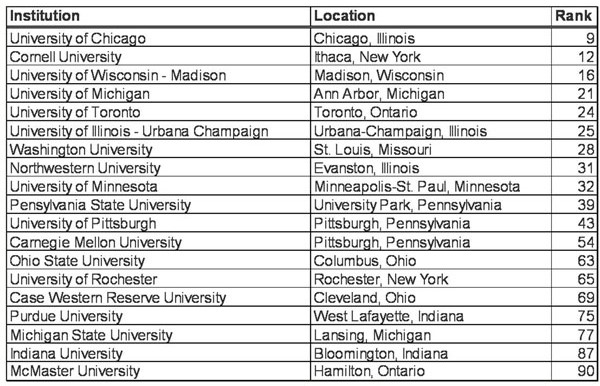Universities and the Great Lakes Economic Revival
Multi-state U.S. regions are defined in a number of ways. One such grouping is the “Great Lakes Region,” comprising all the states that border the Great Lakes. The states that run east to west are New York, Pennsylvania, Ohio, Indiana, Michigan, Illinois, Wisconsin, and Minnesota (map below). During the nineteenth century, the efficient transportation of materials on the Lakes and connecting canals knitted these state economies together into an agricultural, mining, and manufacturing powerhouse.
Figure 1. Great Lakes Region

As waterways transportation has given way to overland and air transportation, the region’s economic cohesion and linkages have loosened. However, these states continue to share many common and inter-connected manufacturing industries, especially steel, autos, and nonelectrical machinery such as farm and construction equipment. For this reason, as these traditional manufacturing industries account for fewer jobs and less income, these Great Lakes states seem to share a common economic destiny.
The Brookings Institution Metropolitan Policy Program is partnering with many local organizations on a multi-year research and policy initiative to try and boost the economic vitality of the region. During the week of October 23, various Great Lakes cities will host a series of discussions following presentations of a broad “framing paper” called The Vital Center: A Federal-State Compact to Renew the Great Lakes Region.
This initial Brookings paper points out several avenues for the region to pursue, with “Innovative Infrastructure” being the most prominent. With a 33% share of national population, the region is said to generate 32% of the nation’s patents, perform 29% of its R&D, and graduate 36% of the nation’s scientists and engineers. The report calls on public and private research facilities in the Great Lakes to work together to take advantage of these and other “innovation” opportunities.
Further, perhaps because they are mostly fixed in location, highly prominent in stature, and somewhat amenable to public policy, the region’s universities are receiving a lot of attention as potential engines of regional growth. On the plus side, by one ranking, 19 of the world’s top 100 universities are located in Great Lakes states and Ontario, Canada. On the negative side, graduates of the region’s universities are increasingly gravitating to the East and West coasts and other out-of-region locales.
Table 1. Ranked Great Lakes institutions (totals to 19 out of the top 100 universities in the world)

Two important public discussions concerning the ability of colleges and universities to affect regional growth and development will take place at Federal Reserve Banks this fall. In addressing the question this coming October 30 in Chicago Rick Mattoon, senior economist, has put together the broader agenda.
As Rick notes in his recent Chicago Fed Letter, the involvement of universities in promoting economic growth and development can take many forms. For one, the spin-off of new local businesses through the transfer of technology from university labs has been an important mechanism for some local economies such as those of Boston, Austin, TX, and Northern California. But in other locales, especially where university research is not prodigious, the primary growth vehicle remains the traditional mission of local schools in producing workers with the skills and talents that match the needs of local industries. And between these two poles, localities vary so widely in their economies and types of universities that a broad spectrum of strategies and roles may be most appropriate in catalyzing regional growth.
At the October 30 event, Richard Lester of MIT will lay out his typology of university–economy relations and their attendant avenues for economic growth. This will be followed by case study discussions from around the Midwest and a panel of university leaders.
On November 16–17, the Cleveland Fed will follow up with a more intensive and focused examination of universities’ roles in innovation. The first day’s agenda addresses how university research leads to economic innovation, and what role geography and proximity play in the productivity of both university research and in local economic growth.
On the second day, the Cleveland conference will present case studies of the university–local economy linkages, “geared toward people in the business community.” Participants will “hear experiences and insights from high-level executives who have faced head-on the challenges and triumphs collaboration can bring.”
As the collaborative Brookings project to stimulate economic activity in the Great Lakes gets underway, these Federal Reserve System discussions should be very helpful in considering how the region’s universities can contribute.








